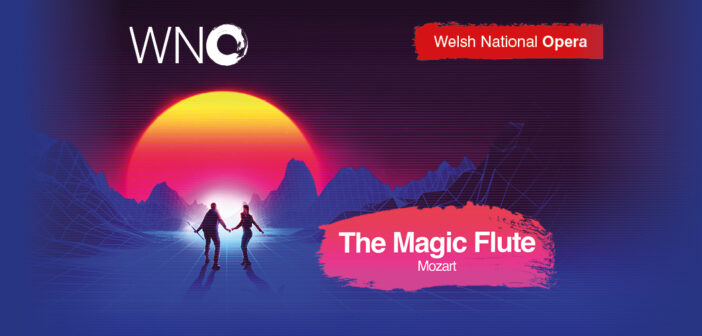An enjoyable experience with fantastic standout performances and set design, contrasting with unique choices of its modern sci-fi adaptation.
-
6
The Welsh National Opera’s bold reimagining of Mozart’s timeless The Magic Flute opened this Tuesday at Southampton’s Mayflower Theatre. Will it live up to expectations?
Daisy Evans’ futuristic reinterpretation is a dizzy cascade of powerful performances, strobing light shows and ultimately good storytelling; casting away the more fantastical elements for high-concept science fiction, the English translation has also been souped up for 21st century standards and made more colloquial by director Evans. Running an opera at the Mayflower, best known for popular musical theatre, is definitely a signal of attempting something radical and inclusive – something I do appreciate.
I’m not a diehard traditionalist, but modernising something just to modernise it without having anything to say can be boring. A German performance of Die Zauberflöte appeals to me as much as an English version – or dare I say a Welsh version of Y Ffliwt Hud. A high-tech Impressionist future depiction of the Night Palace appeals to me as much as a fantasy setting. What matters to me most is performance and experience, how you explore it and what you say with it – and all of that transcend the language used or whether I need to read the surtitles. If anything, the attempts to ground it in modern English were at odds with the confusing timeless future it was attempting to create. There were elements that worked; the minor plot changes served the story well, and made the second act feel more conclusive. On the other hand, Papageno calling people ‘mate’ just didn’t work.
April Koyejo-Audiger’s Pamina was the star performer, with both the most engaging portrayal and a beautiful soprano voice. Thando Mjandana’s Tamino was beautifully captured vocally, though his dialogue felt a little stunted and the banter between him and Papageno didn’t work. As a couple, however, they had perfect chemistry. The repetitive arpeggiated motifs of the Queen of the Night were captured decently by Julia Sitkovetsky. Thomas Kinch’s goofy portrayal of the armed guard stood out for similar reasons, and his interactions with the Papageno and the other guard were a welcome, well-delivered bit of physical comedy.
But if there’s ever a work that lends itself to an abstract reimagining, it is something as bafflingly abstract and impossible as The Magic Flute. The original is as close to a blank slate begging for striking visuals as a dreamlike, Masonic-coded opera about day and night can be. Loren Elstein’s set design and construction was phenomenal and brought a vision to life. The method of constructing scenes from the various fragments of the staging rearranging to form new walls and towers kept me guessing. You never really knew how the three or four components that made the set – all of which comprised of stairs, ladders, and a platform – the stagehands could move would move. Especially impressive was the unexpected moon hidden within the set and its ceremonial lighting during the climax of Act 1.
The backdrop of the set and its tall, harsh contrasting shapes reminded me of Soviet artist and geometric obsessive El Lissitsky. The whole set had a whole primitive CGI feel reminiscent of 90s Pet Shop Boys videos – down to one of the walls having a similar orange Legoesque pattern to the album cover for the Boys’ Very. It’s a shame that this originality isn’t always reflected within the advertising; the vaporwave inspired poster for the show does very little to clue you in on the actual originality of the final show’s design.
The costume design is simultaneously every era of pop science fiction you can envision and none: from the 70s kitsch of the child-spirits and the Armoured Men, to the Tron-esque Spandex aesthetic of Pamina’s costume, to the digital knight in shining electroplated armour that Tamino dons during the trials of Act 2. I don’t mind the clash and contrast in theory, but some of the costuming felt confused and didn’t always cohesively contrast in the way it was intended.
The lighting formed its own character in the world – how apt for a work about light and dark! Jake Wiltshire’s lighting design is definitely imaginative, and often works. The repeated motif of detachable batons of light carried by the cast and its use to resemble portals, arrows, directions, definitely worked. Every panel imaginable had a source of light attached somewhere. At times the lighting was overwhelming and distracting, but overall it definitely complimented the aesthetic and even in its more annoying moments, you could see that there was a vision. However, I do feel some of the more experimental choices could have gone further and some avenues were definitely left unexplored.
I feel like the lighting’s hit-and-miss quality is reflective of the whole performance. Ultimately, the whole show kept people engaged throughout the three hours. Despite the marketing insisting this was an opera for all ages, I think I was the youngest in my row – suggesting the marketing didn’t really work as intended. Like with every form of the arts here in the Solent, there is a deep chasmous yearning for more opera.
However, I think a majority of the audience would have attended The Magic Flute regardless of how it was portrayed. If the modern staging and libretto isn’t for you, you will still be enthralled by the magic of the original work and Theresa Böhm’s orchestration. As a performance, I definitely enjoyed the experience – but its quest to make an accessible, populist opera was not as successful as I’m sure they would have hoped, and ultimately could have stretched so much further.




